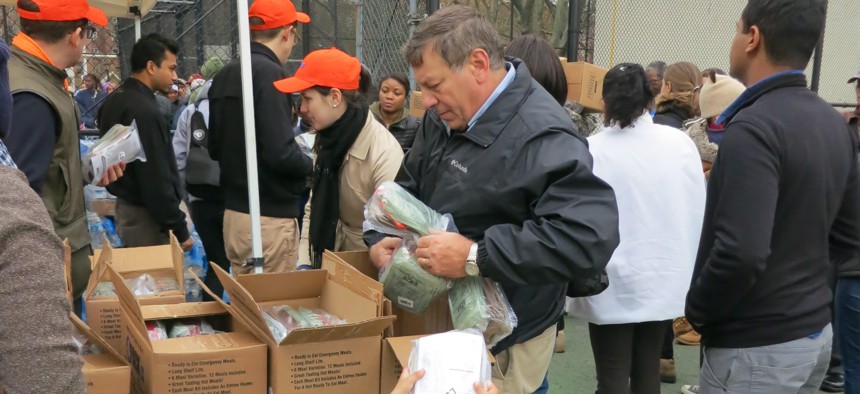Nonprofits
Opinion: How a court’s mission aligned with its response to Superstorm Sandy
The Red Hook Community Justice Center took the same holistic approach to overcoming challenges in the criminal justice system when Superstorm Sandy hit ten years ago.

Judge Alex Calabrese (center) and others from the Red Hook Community Justice Center at work in the aftermath of Superstorm Sandy. (PHOTO COURTESY OF THE CENTER FOR COURT INNOVATION)
Ten years ago, I held a flashlight and clipboard doing door-to-door checks of Red Hook residents. The houses had no lights, no power and no running water at all. Everything was completely dark. Superstorm Sandy had flooded the streets, and the Red Hook Community Justice Center became a crisis and meal distribution center. Our staff worked round-the-clock to deliver water, food, blankets and medical supplies, and identify people in need of emergency care.
We may not have been your typical first responders, but working with local residents to overcome challenges was nothing new. You see, the Justice Center I presided over for the past 22 years is not your typical courthouse.
Launched as a collaboration of the New York State Unified Court System and the Center for Court Innovation in 2000, the Justice Center was the first multijurisdictional court in the country with criminal, family and housing court cases appearing before a single judge. Instead of working in silos, the Justice Center takes a holistic approach. For example, a person can have a criminal court matter – say, possession of drugs – that may result in a family court matter if they have children, that could then result in a housing court matter if they live in public housing. This person can come to the Justice Center and receive support, programming and accountability – all geared towards helping them move forward – instead of having three separate court dates, in three separate buildings.
But the Justice Center is about much more than streamlining the court process. It’s about putting people – and the community – at the center of justice. That means working collaboratively with the community to identify local concerns and creating solutions to address them. In this way, we have increased civic engagement, empowered the local community to advocate for themselves and increased overall safety. We’ve developed innovative programs like peacemaking circles – replicated under the tutelage of traditional Navajo peacemakers – to address interpersonal conflict and driver accountability classes to change behavior of drivers who violate the rules. Anyone in the community can access our programming, including high school equivalency diploma classes, housing resources to help New York City Housing Authority tenants get repairs and pay rent arrears to avoid eviction, and leadership training for youth.
In criminal cases, we issue individualized sentences that prioritize social services that address underlying problems – like substance use or mental health diagnoses – over incarceration.
At a time when people are increasingly concerned about crime, some may think this approach is ineffective, at best, or dangerous, at worst. But a comprehensive report by the National Center for State Courts showed that our approach reduced crime, reduced recidivism, at the same time, significantly reduced incarceration. Furthermore, the evaluation showed that our approach saved money. In fact, the evaluation showed that just our approach to misdemeanor arraignments were able to save $15 million in avoided victimization costs when compared to traditional misdemeanor courts.
Community courts are a model for how we can address some of the most divisive issues we face in our country between community and police. And the model forged in our small corner of Brooklyn has not gone unnoticed. Judiciaries across the world have adapted our approach, with their own justice centers in Olympia, WA, Dallas, TX, and Melbourne, Australia, along with Israel and Ukraine – just to name a few.
On my last day presiding over the Justice Center a few weeks ago, I thought back to 30 years ago, when Red Hook was considered one of the most dangerous neighborhoods in New York City, when you taught your children that when they hear a bang, hit the floor. And then 25 years ago, when we worked with community leaders to articulate the Justice Center’s mission and tour the neighborhood to find the ideal location, which turned out to be a former parochial high school. Fast forward to 10 years ago, when the Justice Center – in the eye of Superstorm Sandy – engaged the community to safeguard our most vulnerable residents and rebuild. And to the last few years, when we provided personal protective equipment, food and other essential services to the community during the pandemic.
And today: as we address the needs of the moment – like helping tenants maintain safe, stable housing during a post-pandemic wave of housing instability, the Justice Center continues to be a place where you can witness, from our staff to our clients, to our partners, the power of the human spirit every day.
Alex Calabrese was the presiding judge of the Red Hook Community Justice Center from 2000 to 2022.
NEXT STORY: Commentary: Mend It, Don’t End It
